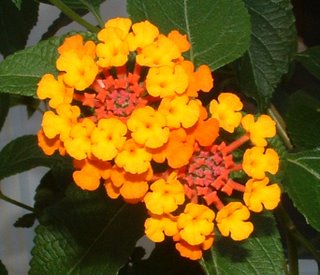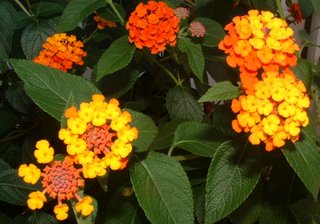

Lantana camara
Common Names: lantana, shrub verbena
Family: Verbenaceae (verbena or vervain family)
This is my new favorite plant for pots on the deck. I bought one in a hanging basket earlier in the summer and transplanted it to one of my big pots. It's done incredibly well, filling the entire pot, demanding very little from me. It seems to thrive in the heat and bright sun, as long as I give it a drink every few days. I finally figured out what the spent blooms look like (wasn't sure if they were buds or old blooms since the flower portion falls off) and did a bit of dead-heading last weekend. Must've made it very happy, as it's blooming all over again. I love the brilliant colors. Definitely a winner and one I'll buy every summer.
Note: After wandering around the Internet, I learned some interesting tidbits about this plant. People either love it or hate it. Some like the fragrance, while others think it has an offensive smell (from one garden site: "In fact, both the Malay and Chinese names for lantana mean 'chicken droppings flower' because of its smell.").
I also learned that it's a noxious weed in some states:
"In Florida and other Southern States this is a noxious weed and EXTREMELY POISONOUS TO LIVESTOCK AND HUMANS. It spreads by the birds eating the berries and everywhere they leave droppings more of these come up. They are IMPOSSIBLE TO KILL - I have tried everything from sprays to digging them up. I have lost livestock to this plant and I attack it aggressively everytime I see just one small plant starting in my pasture. PLEASE GROW THESE WITH CAUTION."
Here is more info on the poisonous aspect of these plants:
From the West VA State University web site:
TOXICITY
This ornamental shrub contains lantanin, a triterpenoid, and other compounds irritating to the mucosa of the gastrointestinal tract. All parts of the plant are quite toxic and poisoning may occur year-round, but is most common in summer and fall. Many poisoning cases occur when clippings are thrown into the pasture.
Sheep, cattle, horses, and humans are sensitive to the effects of the plant. Children have been poisoned by eating the berries.
SYMPTOMS
Cattle are most often affected. There are two forms of toxicity: acute and chronic. The acute form usually occurs within 24 hours after eating the plants with the animal exhibiting gastroenteritis with bloody, watery feces. Severe weakness and paralysis of the limbs are followed by death in three to four days. The chronic form is characterized by jaundiced mucous membranes, photosensitization, ulcerations of the mucous membranes of the nose and oral cavity. The skin may peel, leaving raw areas that are vulnerable to blowfly strike and bacterial infection. Severe keratitis may result in temporary or permanent blindness.
FROM THE UNIVERSITY OF GA WEB SITE:
Description: Lantana is a common ornamental plant. The plant has spreading stems and opposite leaves. The flowers form clusters that are flat-topped and range in color from red-orange to yellow. Lantana poses several problems to the farmer in that ingestion of the plant causes liver damage in animals, the plant inhibits the growth of other plants surrounding it (this includes grasses or other animal fodder), and this plant infests potential pastures causing a decrease in fodder for the animals.
Toxic Part: The entire plant is toxic.
Toxin: The toxic compounds are currently disputed but are believed to be lantadenes, a group of triterpenes.
Symptoms: This plant has demonstrated toxicity when ingested by cattle, buffalo, sheep, and goats. Poisoning occurs after ingestion of a significant amount of foliage (3mg foliage/kg body weight) at one time. The toxicity is not cumulative and not all species of Lantana are toxic. Symptoms of toxicity in animals include photosensitive dermatitis followed by necrosis of large areas of the skin, jaundice and yellowing of the mucous membranes, and loss of appetite with a decrease in ruminal motility. This decrease in ruminal motility may be a reaction to damage to the liver by the toxic constituents of the plant. L. camara poses several problems to the rancher in that ingestion of the plant causes hepatotoxicity (liver toxicity), the plant inhibits growth of nearby grasses and other potential fodder, and this plant infests potential pastures causing a decrease in fodder for the animals. In severe cases death may occur within two days or one to three weeks post-poisoning.
Treatment: Activated charcoal is a successful treatment for Lantana toxicity in animals.
Apparently one family lost its dog after it ingested part of the plant and others have had allergic reactions after touching the leaves.
Good information to be aware of!

2 comments:
Les, this is a wonderful blog. I love the pictures and info you share. I told you already that I lived 6 yrs. in Lincoln. We lived between L and M streets just a few blocks from Hawthorne elementary. Are you familiar with that area?
Thanks, Booklogged! I'm having fun with the blog. It's about as creative as I get. I Googled the school and see where abouts you lived. I've driven by that neighborhood several times recently since O street has been under construction, making it difficult to get to B&N and other points of interest. The detour ran right through your old neighborhood. Small world, eh?
Post a Comment